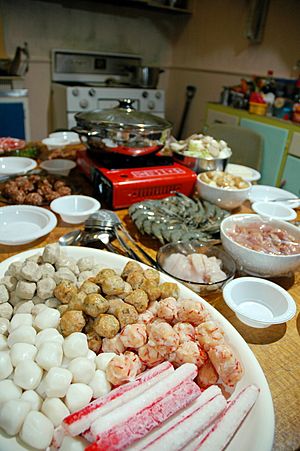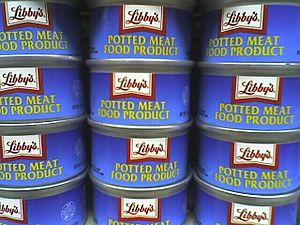Food processing facts for kids

Food processing means the ways that are used to change raw ingredients into food so that they can be eaten by humans or animals. The food processing industry uses these processes. Food processing often takes clean, harvested or slaughtered and butchered components and uses these to produce attractive and marketable food products. Similar process are used to produce animal feed.
Contents
Benefits and drawbacks
Benefits
Benefits of food processing include toxin removal, preservation, easing marketing and distribution tasks, and increasing food consistency. In addition, it increases yearly availability of many foods, enables transportation of delicate perishable foods across long distances and makes many kinds of foods safe to eat by de-activating spoilage and pathogenic micro-organisms. Modern supermarkets would not exist without modern food processing techniques, and long voyages would not be possible.
Processed foods are usually less susceptible to early spoilage than fresh foods and are better suited for long distance transportation from the source to the consumer. When they were first introduced, some processed foods helped to alleviate food shortages and improved the overall nutrition of populations as it made many new foods available to the masses.
Processing can also reduce the incidence of food borne disease. Fresh materials, such as fresh produce and raw meats, are more likely to harbour pathogenic micro-organisms (e.g. Salmonella) capable of causing serious illnesses.
The extremely varied modern diet is only truly possible on a wide scale because of food processing. Transportation of more exotic foods, as well as the elimination of much hard labour gives the modern eater easy access to a wide variety of food unimaginable to their ancestors.
The act of processing can often improve the taste of food significantly.
Mass production of food is much cheaper overall than individual production of meals from raw ingredients. Therefore, a large profit potential exists for the manufacturers and suppliers of processed food products. Individuals may see a benefit in convenience, but rarely see any direct financial cost benefit in using processed food as compared to home preparation.
Processed food freed people from the large amount of time involved in preparing and cooking "natural" unprocessed foods. The increase in free time allows people much more choice in life style than previously allowed. In many families the adults are working away from home and therefore there is little time for the preparation of food based on fresh ingredients. The food industry offers products that fulfill many different needs: e.g. fully prepared ready meals that can be heated up in the microwave oven within a few minutes.
Modern food processing also improves the quality of life for people with allergies, diabetics, and other people who cannot consume some common food elements. Food processing can also add extra nutrients such as vitamins.
Drawbacks
Any processing of food can decrease its nutritional density. The amount of nutrients lost depends on the food and processing method. For example, heat destroys vitamin C. Therefore, canned fruits possess less vitamin C than their fresh alternatives. The USDA conducted a study of nutrient retention in 2004, creating a table of foods, levels of preparation, and nutrition.
New research highlighting the importance to human health of a rich microbial environment in the intestine indicates that abundant food processing (not fermentation of foods) endangers that environment.
Using food additives represents another safety concern. The health risks of any given additive vary greatly from person to person; for example using sugar as an additive endangers diabetics. In the European Union, only European Food Safety Authority (EFSA) approved food additives (e.g., sweeteners, preservatives, stabilizers) are permitted at specified levels for use in food products. Approved additives receive an E number (E for Europe), simplifying communication about food additives included in the ingredients' list for all the different languages spoken in the EU. As effects of chemical additives are learnt, changes to laws and regulatory practices are made to make such processed foods more safe.
Food processing is typically a mechanical process that utilizes large mixing, grinding, chopping and emulsifying equipment in the production process. These processes introduce a number of contamination risks. As a mixing bowl or grinder is used over time, metal parts in contact with food will tend to fail and fracture. This type of failure will introduce into the product stream small to large metal contaminants. Further processing of these metal fragments will result in downstream equipment failure and the risk of ingestion by the consumer. Food manufacturers utilize industrial metal detectors to detect and reject automatically any metal fragment. Large food processors will utilize many metal detectors within the processing stream to reduce both damage to processing machinery as well as risk to consumer health.
Industries
Food processing industries and practices include the following:
- Cannery
- Cooking
- Industrial rendering
- Meat packing plant
- Slaughterhouse
- Sugar industry
- Vegetable packing plant
Related pages
Images for kids
-
Michael Foods egg-processing plant in Wakefield, Nebraska
-
A form of pre-made split-pea soup that has become traditional
See also
 In Spanish: Procesado de los alimentos para niños
In Spanish: Procesado de los alimentos para niños









